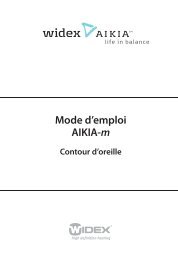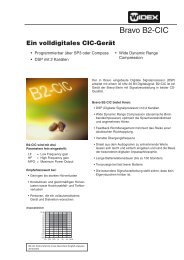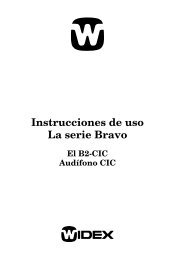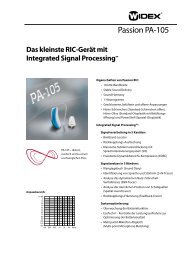User manual, Instant ear-tips for Widex BTE hearing aids
User manual, Instant ear-tips for Widex BTE hearing aids
User manual, Instant ear-tips for Widex BTE hearing aids
You also want an ePaper? Increase the reach of your titles
YUMPU automatically turns print PDFs into web optimized ePapers that Google loves.
USER MANUALEAR-SETS FORWIDEX <strong>BTE</strong> HEARING AIDS<strong>Instant</strong> <strong>ear</strong>-<strong>tips</strong>
CONTENTSINTRODUCTION. . . . . . . . . . . . . . . . . . . . . . . . . . . . . . . . . . . . . . . . 3OVERVIEW AND TICK BOXES . . . . . . . . . . . . . . . . . . . . . . . . . . . . 4INSTANT EAR-TIPS . . . . . . . . . . . . . . . . . . . . . . . . . . . . . . . . . . . . . 6Left/right identification . . . . . . . . . . . . . . . . . . . . . . . . . . . . . . . . . 7Positioning the h<strong>ear</strong>ing aid and instant <strong>ear</strong>-tip . . . . . . . . . . . . . 8Removing the h<strong>ear</strong>ing aid and instant <strong>ear</strong>-tip . . . . . . . . . . . . . . 9Cleaning . . . . . . . . . . . . . . . . . . . . . . . . . . . . . . . . . . . . . . . . . . . . . . 10CHANGING THE EAR-SET PARTS . . . . . . . . . . . . . . . . . . . . . . . . 16Placing the new/clean <strong>ear</strong>-tip on the <strong>ear</strong>-set . . . . . . . . . . . . . . 17THE NANOCARE WAX GUARD . . . . . . . . . . . . . . . . . . . . . . . . . . 19Changing the wax guard . . . . . . . . . . . . . . . . . . . . . . . . . . . . . . . 20THE LOOSE ANCHOR . . . . . . . . . . . . . . . . . . . . . . . . . . . . . . . . . . 23THE INTEGRATED ANCHOR. . . . . . . . . . . . . . . . . . . . . . . . . . . . . 27TROUBLESHOOTING . . . . . . . . . . . . . . . . . . . . . . . . . . . . . . . . . . 31Ear-<strong>tips</strong> with an <strong>ear</strong>wire . . . . . . . . . . . . . . . . . . . . . . . . . . . . . . . . 31Ear-<strong>tips</strong> with a tube . . . . . . . . . . . . . . . . . . . . . . . . . . . . . . . . . . . . 32WARNINGS. . . . . . . . . . . . . . . . . . . . . . . . . . . . . . . . . . . . . . . . . . . 33MAINTENANCE . . . . . . . . . . . . . . . . . . . . . . . . . . . . . . . . . . . . . . . 342
INTRODUCTIONThis booklet provides an overview of different instant<strong>ear</strong>-set solutions available <strong>for</strong> <strong>Widex</strong> behind-the-<strong>ear</strong>(<strong>BTE</strong>) h<strong>ear</strong>ing <strong>aids</strong>. An <strong>ear</strong>-set consists of an <strong>ear</strong>-tipattached to a tube or an <strong>ear</strong>wire and receiver. The <strong>ear</strong>setis used to channel sound from the behind-the-<strong>ear</strong>h<strong>ear</strong>ing aid into the <strong>ear</strong> canal.WARNINGThis booklet contains important in<strong>for</strong>mation and instructionsregarding your <strong>ear</strong>-set, and complements the user instructions<strong>for</strong> your h<strong>ear</strong>ing aid. In addition to the user instructions <strong>for</strong> yourh<strong>ear</strong>ing aid, please be sure to read the sections in this bookletthat apply to your <strong>ear</strong>-set solution be<strong>for</strong>e you start using theh<strong>ear</strong>ing aid.NOTEYour <strong>ear</strong>-set may not look exactly as illustrated in this booklet.We also reserve the right to make any changes considerednecessary.3
OVERVIEW AND TICK BOXESYour h<strong>ear</strong>ing care professional should tick the box ofthe chosen solution.<strong>Instant</strong> <strong>ear</strong>-<strong>tips</strong><strong>Instant</strong> receiver <strong>ear</strong>-tip & RIC <strong>ear</strong>wire<strong>Instant</strong> receiver open <strong>ear</strong>-tip, <strong>for</strong> RIC S & RIC M<strong>Instant</strong> receiver tulip <strong>ear</strong>-tip, <strong>for</strong> RIC S, RIC M & RIC P<strong>Instant</strong> receiver double <strong>ear</strong>-tip, <strong>for</strong> RIC S, RIC M & RIC PSections to readpageIntroduction 3Overview and tick boxes 4-5<strong>Instant</strong> <strong>ear</strong>-<strong>tips</strong> 6-18The NanoCare wax guard 19-22The loose anchor 23-26Troubleshooting 31Warnings 33Maintenance, etc. 34-35H<strong>ear</strong>ing aid model: ______________________Earwire:Left _____ Right ______Ear-tip size: Left _____ Right ______4
<strong>Instant</strong> <strong>ear</strong>-tip & élan/thin tube<strong>Instant</strong> open <strong>ear</strong>-tip, <strong>for</strong> élan/thin tube<strong>Instant</strong> tulip <strong>ear</strong>-tip, <strong>for</strong> élan/thin tube<strong>Instant</strong> double <strong>ear</strong>-tip, <strong>for</strong> élan/thin tubeSections to readpageIntroduction 3Overview and tick boxes 4-5<strong>Instant</strong> <strong>ear</strong>-<strong>tips</strong> 6-17The anchor 23-30Troubleshooting 32Warnings 33Maintenance, etc. 34-35H<strong>ear</strong>ing aid model: ______________________Tube size:Left _____ Right ______Ear-tip size: Left _____ Right ______5
INSTANT EAR-TIPSThe instant <strong>ear</strong>-tip is used with a RIC <strong>ear</strong>wire or an élan/thin tube, depending on the h<strong>ear</strong>ing aid model. In a RICsolution, the receiver or loudspeaker of the h<strong>ear</strong>ing aidis placed at the end of the <strong>ear</strong>wire. In an élan/thin tubesolution, the receiver is located inside the h<strong>ear</strong>ing aidhousing. Under “Overview and Tick Boxes”, you can seewhich solution has been chosen <strong>for</strong> you.RIC1. Earwire2. Receiver1élan/thin tubem & FA modelsélan/thin tube9-models2Receiveropen <strong>ear</strong>-tipOpen <strong>ear</strong>-tipReceivertulip <strong>ear</strong>-tipTulip <strong>ear</strong>-tipReceiverdouble <strong>ear</strong>-tipDouble <strong>ear</strong>-tip6
Left/right identificationThe illustration shows an <strong>ear</strong>wire. Earwires/tubesare available in differentlengths <strong>for</strong> the right and left <strong>ear</strong>, respectively.The individual size is printed onthe <strong>ear</strong>wire/tube (see arrow). Red printindicates that it is <strong>for</strong> the right <strong>ear</strong>, andblue print that it is <strong>for</strong> the left <strong>ear</strong>.7
Positioning the h<strong>ear</strong>ing aid and instant <strong>ear</strong>-tipThe illustrations show an open <strong>ear</strong>-tip with an anchor,but the same procedure is used <strong>for</strong> the other instant<strong>ear</strong>-tip types.Place the h<strong>ear</strong>ing aid behind the <strong>ear</strong>, so that the <strong>ear</strong>wire/tube rests com<strong>for</strong>tably on the <strong>ear</strong>, close to your head.Insert the <strong>ear</strong>-tip into the <strong>ear</strong> canal while holding thelower part of the <strong>ear</strong>wire/tube.If you have a tulip <strong>ear</strong>-tip, make sure that the larger leafis positioned over and overlaps the smaller leaf.An anchor is used <strong>for</strong> some instant <strong>ear</strong>-<strong>tips</strong> to helpsecure the <strong>ear</strong>-set in the <strong>ear</strong>. Please refer to pages23-30 <strong>for</strong> further in<strong>for</strong>mation.8
Removing the h<strong>ear</strong>ing aid and instant <strong>ear</strong>-tipRemove the h<strong>ear</strong>ing aid from its position behind the<strong>ear</strong>.Carefully pull the <strong>ear</strong>-tip out of the <strong>ear</strong> canal, whileholding the lower part of the <strong>ear</strong>wire/tube.9
CleaningCleaning accessories*.1. Cloth2. Long wax removing tool3. Brush4. Cleaning thread1234Contact your h<strong>ear</strong>ing care professional if you needadditional supplies of cleaning accessories.* Selection depends on <strong>ear</strong>-set type.10
<strong>Instant</strong> receiver <strong>ear</strong>-tip & RIC <strong>ear</strong>wire(On pages 13-15 you can see how to clean an instant<strong>ear</strong>-tip & élan/thin tube).Make sure that your <strong>ear</strong>-set is always clean and free of<strong>ear</strong>wax, moisture and the like.WARNINGNever use alcohol or other cleaning solutions to clean the <strong>ear</strong>set,as this can discolour it.Clean the <strong>ear</strong>wire with the clothafter use.WARNINGNever use water or cleaning solutions to clean the <strong>ear</strong>wire.The receiver must never come into contact with water, as thiscan damage the receiver.If dirt has collected on the receiver, use the cloth toremove it, after first pulling the receiver out of the <strong>ear</strong>-tip.11
If necessary, the open, tulip & double<strong>ear</strong>-tip can be rinsed thoroughly inlukewarm water, after disconnectingit from the rest of the <strong>ear</strong>-set. Allowit to dry overnight.Ear-<strong>tips</strong> in which a receiver is inserted use a waxguard. Please refer to pages 19-22.12
<strong>Instant</strong> <strong>ear</strong>-tip & élan/thin tubeMake sure that your <strong>ear</strong>-set is always clean and free of<strong>ear</strong>wax, moisture and the like.WARNINGNever use alcohol or other cleaning solutions to clean the <strong>ear</strong>set,as this can discolour it.13
m and FA modelsGrip the h<strong>ear</strong>ing aid betweenyour thumb and index finger.With your other hand gripthe élan/thin tubing and pullstraight apart as indicated by the arrow. Alternatively,a small tool is available <strong>for</strong> removing the tubing. Contactyour h<strong>ear</strong>ing care professional if you want morein<strong>for</strong>mation.Pull the <strong>ear</strong>-tip off the tubing.The illustrations show an open<strong>ear</strong>-tip.Pass the cleaning thread throughthe tubing. Pull the thread out atthe other end.If necessary, the open, tulip & double<strong>ear</strong>-tip can be rinsed thoroughly inlukewarm water, after disconnectingit from the rest of the <strong>ear</strong>-set. Allowit to dry overnight.14
9-modelsLift the <strong>ear</strong>-set off the h<strong>ear</strong>ingaid in a slanting, backwardmovement, as shown.Pull the <strong>ear</strong>-tip off the élan/thintubing. The illustrations show aninstant open <strong>ear</strong>-tip.Pass the cleaning thread throughthe tubing. Pull the thread out atthe other end.If necessary, the open, tulip & double<strong>ear</strong>-tip can be rinsed thoroughly inlukewarm water, after disconnectingit from the rest of the <strong>ear</strong>-set. Allowit to dry overnight.15
CHANGING THE EAR-SET PARTSThe <strong>ear</strong>-set parts should be changed as required. Thelife of an <strong>ear</strong>-set is individual. Consult your h<strong>ear</strong>ingcare professional <strong>for</strong> advice on how often you shouldchange your <strong>ear</strong>-set parts.For further supplies of <strong>ear</strong>-sets, or if the <strong>ear</strong>-tip size nolonger fits your <strong>ear</strong>, contact your h<strong>ear</strong>ing care professional.16
Placing the new/clean <strong>ear</strong>-tip on the <strong>ear</strong>-setGently insert the tubing/receiver at the end of the <strong>ear</strong>wireinto the <strong>ear</strong>-tip until it touches the end. It is veryimportant to ensure that the <strong>ear</strong>-tip is firmly secured.Open, tulip, double <strong>ear</strong>-tip:NOTEWhen inserting a receiver into the <strong>ear</strong>-tip, you should feel itclick into place.17
Vent block (RIC solution)The instant receiver double <strong>ear</strong>-tip is provided with avent. If a closed solution has been chosen, the vent willbe blocked by a vent block.When you replace the <strong>ear</strong>-tip, you will there<strong>for</strong>e alsoneed to insert a new vent block.Insert the pointed end of the block all the way into thevent from the inside, as shown. Break off the pointedend. Make sure it sits securely in the vent.18
THE NANOCARE WAX GUARDA NanoCare wax guard is used with RIC solutions, inwhich the receiver sits in the <strong>ear</strong>-tip.The NanoCare wax guard helps to protect the h<strong>ear</strong>ingaid against <strong>ear</strong>wax. Always use NanoCare wax guardswith your h<strong>ear</strong>ing aid if you have a RIC solution. Otherwisethe warranty <strong>for</strong> your h<strong>ear</strong>ing aid will be void.The wax guard system consists of the following parts:1. Holder2. Removal hook3. Wax guard123CAUTIONThe wax guard is disposable and <strong>for</strong> one-time use only. Do notattempt to clean or reuse a wax guard. This could damage yourh<strong>ear</strong>ing aid and/or cause the wax guard to become dislodgedin your <strong>ear</strong>.19
Changing the wax guard1. Insert the removal hook into the used wax guardplaced in the sound outlet.2. Pull the wax guard straight out.12Now turn the holder around so thatthe used wax guard is away from thereceiver and the new one is in positionto be inserted.20
3. Insert the holder into the opening of the soundoutlet and gently press the wax guard onto thereceiver.4. Pull the holder straight out. The new wax guardwill automatically detach from the holder. Pressthe receiver/<strong>ear</strong>-tip gently against a flat surface toensure that the wax guard remains in place.3.4.21
Discard the holder with the usedwax guard.The frequency with which the wax guard should bechanged varies from one individual to another.If you have any questions regarding your wax guard,please contact your h<strong>ear</strong>ing care professional.WARNINGIf the wax guard fits loosely, discard it and insert another. If thewax guard becomes dislodged while the <strong>ear</strong>-tip is placed in the<strong>ear</strong> canal, please contact your physician. Do not try to removethe wax guard from your <strong>ear</strong> canal yourself.22
THE LOOSE ANCHORCAUTIONWe do not recommend w<strong>ear</strong>ing the h<strong>ear</strong>ing aid without theanchor with the open <strong>ear</strong>-tip or the tulip <strong>ear</strong>-tip solution. If theh<strong>ear</strong>ing aid is not secured by the anchor, it may fall off your<strong>ear</strong> and be lost. The anchor is not used with the double <strong>ear</strong>-tip.The anchor is supplied separatelyfrom the rest of the <strong>ear</strong>-set and canbe used in different ways. Firstly, weshow how the anchor can be usedwithout prior trimming:23
The illustrations show a h<strong>ear</strong>ing aidwith an an instant open receiver <strong>ear</strong>tipbut the same procedure is usedwith a tulip <strong>ear</strong>-tip.Pull the pointed end of the anchorthrough the upper hole on thereceiver located at the end of the <strong>ear</strong>wire.The angled grip should be pointingtowards the h<strong>ear</strong>ing aid.Continue pulling until the anchor is stopped by the gripat the end.Your <strong>ear</strong>-set is now ready <strong>for</strong> use and ispositioned so that it rests com<strong>for</strong>tably inyour <strong>ear</strong>.24
The anchor can also be trimmed to fit your <strong>ear</strong>:Pull the pointed end of the anchorthrough the upper hole on thereceiver located at the end of the <strong>ear</strong>wire.The angled grip should be pointingtowards the h<strong>ear</strong>ing aid.Continue pulling until the anchor is stopped by the gripat the end. Now turn the <strong>ear</strong>-set around.Then guide the pointed end of theanchor through the lower hole to <strong>for</strong>ma loop.When the loop is the correct size, cutany excess off, leaving only the loop.The anchor loop has the correct size whenit supports the position of the <strong>ear</strong>-tip inthe <strong>ear</strong> canal, and the <strong>ear</strong>-set sits securelyin and on the <strong>ear</strong>.25
Take great care to cut off all theexcess so that the end of the anchorloop is flush with the small hole andthere are no sharp edges. Use thetip of your finger to check <strong>for</strong> sharpedges. If part of the anchor sticks outthrough the hole, creating an uneven surface, this maycause irritation of the <strong>ear</strong>.26
Example 1Pull the tip of the anchor through the small hole on theside of the tubing.When the loop is the correct size,cut off any excess with scissors orsimilar.The anchor loop has the correct size whenit supports the position of the <strong>ear</strong>-tip inthe <strong>ear</strong> canal, and the <strong>ear</strong>-set sits securelyin and on the <strong>ear</strong>.28
Example 2Loop the anchor in the direction indicatedby the dotted line and arrows.Guide the tip of the anchor throughthe small hole on the side of thetubing as illustrated to <strong>for</strong>m a h<strong>ear</strong>tshapedloop.When the loop is the correct size,turn the <strong>ear</strong>-set around and cut offany excess with scissors or similar.The anchor loop has the correct size whenit supports the position of the <strong>ear</strong>-tip inthe <strong>ear</strong> canal, and the <strong>ear</strong>-set sits securelyin and on the <strong>ear</strong>.29
General in<strong>for</strong>mation:Make sure that the end of the anchor loop is flush withthe small hole and there are no sharp edges. Use the tipof your finger to check <strong>for</strong> sharp edges.If part of the anchor sticks outthrough the hole, creating an unevensurface, this may cause irritationof the <strong>ear</strong>.30
TROUBLESHOOTINGEar-<strong>tips</strong> with an <strong>ear</strong>wireThe following pages contain some advice on what todo if your h<strong>ear</strong>ing aid malfunctions or fails to per<strong>for</strong>msatisfactorily. If the problems persist, contact yourh<strong>ear</strong>ing care professional. The advice relates only tothe <strong>ear</strong>-set. Please also see the user instructions <strong>for</strong>your h<strong>ear</strong>ing aid.The h<strong>ear</strong>ing aid is completely silentThe wax guard is blockedChange the wax guardThe <strong>ear</strong>wire is brokenContact your h<strong>ear</strong>ing care professionalThe h<strong>ear</strong>ing aid volume is not powerful enoughThe wax guard is blockedChange the wax guardThe h<strong>ear</strong>ing aid whistles continuouslyThe <strong>ear</strong>-tip is not correctly placed in your <strong>ear</strong> canalTake the <strong>ear</strong>-tip out and reinsert it. If the problempersists, contact your h<strong>ear</strong>ing care professionalThe <strong>ear</strong>-tip fit is too looseContact your h<strong>ear</strong>ing care professionalThe receiver is not adequately secured in the <strong>ear</strong>-tipReplace the <strong>ear</strong>-tip. If the problem persists, contactyour h<strong>ear</strong>ing care professional31
WARNINGSWARNING• The h<strong>ear</strong>ing aid is made of modern non-allergenic materials.Nonetheless, in rare cases skin irritation may occur. If younotice skin irritation in or around your <strong>ear</strong> or <strong>ear</strong> canal, contactyour h<strong>ear</strong>ing care professional.• Be aware that the use of any type of h<strong>ear</strong>ing aid may involvea slightly increased risk of infection in the <strong>ear</strong> canal. An infectioncan arise as a result of inadequate ventilation of the <strong>ear</strong>.We there<strong>for</strong>e recommend that you remove the h<strong>ear</strong>ing aidand <strong>ear</strong>-set from your <strong>ear</strong> at night to allow the <strong>ear</strong> canal to beventilated. Make sure that you clean and inspect your h<strong>ear</strong>ingaid and <strong>ear</strong>-set as required. If an infection occurs, you shouldseek medical attention and contact your h<strong>ear</strong>ing care professional<strong>for</strong> advice on how to disinfect the various h<strong>ear</strong>ing aidparts. Do not under any circumstances use alcohol, chlorineor similar substances.33
MAINTENANCEThe h<strong>ear</strong>ing aid is a valuable object and should betreated with care. Here are some things you can do toprolong the life of your h<strong>ear</strong>ing aid:CAUTION• Turn off your h<strong>ear</strong>ing aid when it is not in use. Remove thebattery if the h<strong>ear</strong>ing aid will not be used <strong>for</strong> several days.• When the h<strong>ear</strong>ing aid is not in use, keep it in its case in a drylocation out of reach of children and pets.• Do not expose the h<strong>ear</strong>ing aid to extreme temperatures orhigh humidity. Make sure to dry the h<strong>ear</strong>ing aid thoroughlyafter heavy perspiration such as that which may occur duringintense physical activity, e.g. playing sports.• Avoid dropping your h<strong>ear</strong>ing aid – per<strong>for</strong>m cleaning and batterychanges while holding the h<strong>ear</strong>ing aid above a soft surface.• Do not w<strong>ear</strong> your h<strong>ear</strong>ing aid while in the shower or swimming,or when using a hair dryer, perfume, hair and bodysprays or gels such as suntanning lotions or creams.• In environments with high humidity, a drying kit may be useddaily to reduce the amount of moisture inside the h<strong>ear</strong>ing aid.See the instructions enclosed with the drying kit.34
H<strong>ear</strong>ing <strong>aids</strong>, accessories and batteriesshould not be disposed of with normalhousehold waste. Please consult yournational <strong>Widex</strong> distributor <strong>for</strong> advice onhow to dispose of these items.35
Manufacturer¡9 514 0176 0018¤ ¡#01v¤Printed by HTO / 2013-049 514 0249 001 #01

















